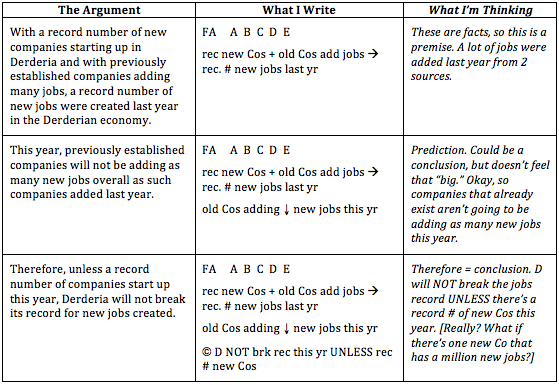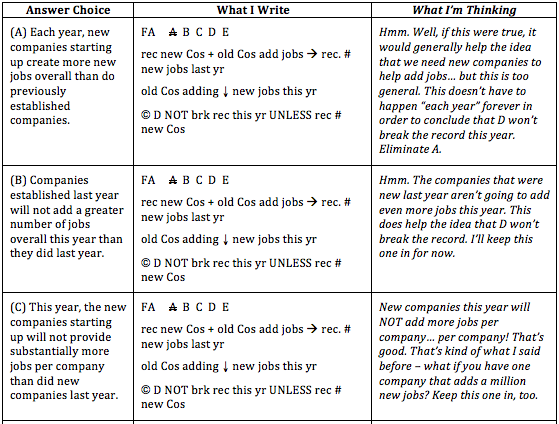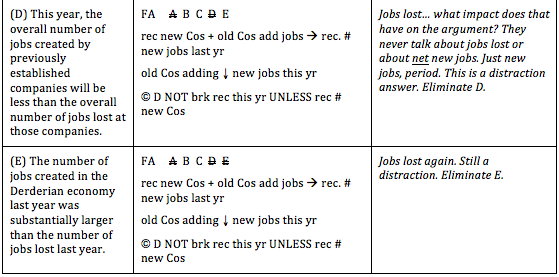-
Target Test Prep 20% Off Flash Sale is on! Code: FLASH20
Redeem
Tackling Find the Assumption CR Problems
 Last week, we discussed the general process for tackling Critical Reasoning problems. This week, lets go through a specific problem together using our process.
Last week, we discussed the general process for tackling Critical Reasoning problems. This week, lets go through a specific problem together using our process.
First, a reminder. Our 4-step process is:
Step 1: Identify the question.
Step 2: Deconstruct the argument.
Step 3: State the Goal.
Step 4: Work from wrong to right.
Okay, set your timer for 2 minutes and try this GMATPrep problem:
With a record number of new companies starting up in Derderia and with previously established companies adding many jobs, a record number of new jobs were created last year in the Derderian economy. This year, previously established companies will not be adding as many new jobs overall as such companies added last year. Therefore, unless a record number of companies start up this year, Derderia will not break its record for new jobs created.Which of the following is an assumption on which the argument relies?
(A) Each year, new companies starting up create more new jobs overall than do previously established companies.
(B) Companies established last year will not add a greater number of jobs overall this year than they did last year.
(C) This year, the new companies starting up will not provide substantially more jobs per company than did new companies last year.
(D) This year, the overall number of jobs created by previously established companies will be less than the overall number of jobs lost at those companies.
(E) The number of jobs created in the Derderian economy last year was substantially larger than the number of jobs lost last year.
Got your answer? Lets start going through this one!
Step 1: Identify the Question
The question stem contains the word assumption, which is a pretty good clue that this is a Find the Assumption (FA) question. Im expecting to find a conclusion when I read the argument and, if I can, Im going to brainstorm any assumptions I can think of without taking too much time.
Step 2: Deconstruct the Argument
Okay, well Ive spotted one potential assumption. This author assumes that you have to have a certain number of new companies in order to reach a certain number of new jobs, but thats not necessarily true. You could have just one new company that adds a huge number of new jobs.
Step 3: State the Goal
D established a record for new jobs last year because a lot of new and old companies added a bunch of jobs. This year the old companies arent going to add as many jobs, so the author claims that D cant break its new jobs record unless even more new companies start up this year. (Note: you would probably say this to yourself more quickly in actual practice.)
This is an assumption question, so I have to find something the author MUST believe to be true in order to draw this conclusion. One thing Ive thought of: the authors assuming that you have to have more new companies in order to have more new jobs.
Step 4: Work from Wrong to Right
We still have two answers left, B and C, so now we compare them.
Lets see. Answer B talks about companies established last year. Are those considered new or old now? When talking about this year, the argument says previously established companies meaning previous to this year so companies established last year are old companies now. So the answers saying a subset of the old companies wont add even more jobs this year wait a second! The argument says all the old companies combined wont be adding as many new jobs. It might be reasonable in the real world to think that just this subset of the big group companies-started-last-year-but-old-now also wont add more new jobs, but those kinds of real-world likely to be true inferences are deadly on the GMAT. Plus, it doesn't matter what this subgroup does; I already know that the overall group is not going to add more jobs than last year. Bs not looking so good anymore.
What about C? New companies this year will NOT offer a lot more jobs per company yes, thats what I said before I even looked at the answers. The author is assuming that we need to have a huge number of new companies in order to have a huge number of new jobs, but if each new company just offers a larger number of new jobs, then D could break the jobs record even though there isnt a record number of new companies this year. So the author must assume thats not going to happen. Bingo!
The correct answer is C.
Take-aways for Find the Assumption (FA) CR questions:
(1) Know how to identify the question type. Most FA questions contain some form of the word assume or assumption, though occasionally the question will ask what information is required or what information would allow the conclusion to be more properly drawn.
(2) Deconstruct the argument according to the goals for this type. FA questions all have conclusions and they all hinge on finding some assumption, so I should be looking for these things as I read the argument. I dont have endless time to brainstorm assumptions; Ill have a better shot at thinking of one or two efficiently if I know to think about it while Im reading the argument for the first time.
(3) Remind yourself of your goal. At first, you may need to say to yourself: For FA questions, I need to find something that the author must believe to be true in order to draw that conclusion. Some trap answers might involve something the author could believe to be true, but thats not good enough. Longer term, you may be able to say to yourself, simply, "Find Assumption" and know what that entails.
(4) Cross off wrong answers first, then worry about finding the right answer. Dont waste time trying to decide whether B is actually correct when you havent looked at C, D, or E yet. Eliminate first, then compare any remaining answers, as we did on this problem. Watch out for traps! On Assumption questions, one common trap answer tells us something thats reasonable to believe could be true in the real world, but the author doesnt absolutely have to believe that its true in order to get to his conclusion.
* GMATPrep questions courtesy of the Graduate Management Admissions Council. Usage of this question does not imply endorsement by GMAC.
Recent Articles
Archive
- April 2024
- March 2024
- February 2024
- January 2024
- December 2023
- November 2023
- October 2023
- September 2023
- July 2023
- June 2023
- May 2023
- April 2023
- March 2023
- February 2023
- January 2023
- December 2022
- November 2022
- October 2022
- September 2022
- August 2022
- July 2022
- June 2022
- May 2022
- April 2022
- March 2022
- February 2022
- January 2022
- December 2021
- November 2021
- October 2021
- September 2021
- August 2021
- July 2021
- June 2021
- May 2021
- April 2021
- March 2021
- February 2021
- January 2021
- December 2020
- November 2020
- October 2020
- September 2020
- August 2020
- July 2020
- June 2020
- May 2020
- April 2020
- March 2020
- February 2020
- January 2020
- December 2019
- November 2019
- October 2019
- September 2019
- August 2019
- July 2019
- June 2019
- May 2019
- April 2019
- March 2019
- February 2019
- January 2019
- December 2018
- November 2018
- October 2018
- September 2018
- August 2018
- July 2018
- June 2018
- May 2018
- April 2018
- March 2018
- February 2018
- January 2018
- December 2017
- November 2017
- October 2017
- September 2017
- August 2017
- July 2017
- June 2017
- May 2017
- April 2017
- March 2017
- February 2017
- January 2017
- December 2016
- November 2016
- October 2016
- September 2016
- August 2016
- July 2016
- June 2016
- May 2016
- April 2016
- March 2016
- February 2016
- January 2016
- December 2015
- November 2015
- October 2015
- September 2015
- August 2015
- July 2015
- June 2015
- May 2015
- April 2015
- March 2015
- February 2015
- January 2015
- December 2014
- November 2014
- October 2014
- September 2014
- August 2014
- July 2014
- June 2014
- May 2014
- April 2014
- March 2014
- February 2014
- January 2014
- December 2013
- November 2013
- October 2013
- September 2013
- August 2013
- July 2013
- June 2013
- May 2013
- April 2013
- March 2013
- February 2013
- January 2013
- December 2012
- November 2012
- October 2012
- September 2012
- August 2012
- July 2012
- June 2012
- May 2012
- April 2012
- March 2012
- February 2012
- January 2012
- December 2011
- November 2011
- October 2011
- September 2011
- August 2011
- July 2011
- June 2011
- May 2011
- April 2011
- March 2011
- February 2011
- January 2011
- December 2010
- November 2010
- October 2010
- September 2010
- August 2010
- July 2010
- June 2010
- May 2010
- April 2010
- March 2010
- February 2010
- January 2010
- December 2009
- November 2009
- October 2009
- September 2009
- August 2009


